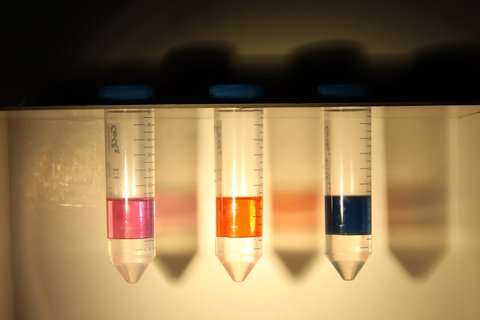Fast, safe solvent for metal decontamination discovered

The solvents currently used to remove specific metals from water all have disadvantages: safety risks are high, the process is slow, they are expensive or not very environmentally friendly. Researchers at TU/e have now produced a new type of solvent that is especially quick, safe, easy to make, cheap and much more environmentally friendly than many of the alternatives. The researchers believe that the potential is enormous – for industry, water purification and for the recovery of rare metals. The result has been published in the science journal Chemical Communications.
The classical method of removing specific metals from water is to use volatile organic solvents. While it is effective, it is not all that safe and the solvents are often toxic. For these reasons the scientific community is keen to find alternatives. It was towards the turn of the century that this alternative was found in the shape of ionic liquids. However, these are problematic in that production is difficult and they still need organic solvents, which makes them expensive, and their viscosity makes them difficult to apply on an industrial scale.
Last year PhD students Dannie van Osch and Lawien Zubeir, among others, discovered a new category of solvents, 'hydrophobic (water-resistant) deep eutectic solvents'. Production is simple: merge the elements and a couple of hours shaking is all that it needed.
Now Van Osch has revealed how his hydrophobic DES can remove heavy metals like nickel and iron from water in just a few seconds. How? By robustly shaking the solvent through the contaminated water. The solvent absorbs the metals, and starts to float up on the water almost immediately due to its water-resistant property. The subsequent separation of water and solvent is then straightforward. Because the agent, in contrast to the volatile solvent, hardly vaporizes, the safety risks are virtually non-existent.
Deep eutectic solvents (DESs) were discovered in 2003. Even for chemists these are amazing substances. They are created by mixing two solids. Normally nothing happens when solids are mixed, but specific combinations of substances all at once become liquid, and this creates a DES. Since 2003 there has been an explosion of research into DES's, which has revealed that they have all kinds of special properties.
However, they didn't appear to be suitable for purifying water because they dissolve so easily in water. And substances that dissolve in water are not what you want as a water purifier since they are difficult to extract from the water. The two substances that together form a DES had to date been highly dissolvable in water so it had not been expected that a water-resistant DES category would be found. "At first, we thought this is not possible," Van Osch says. But he and his fellow researchers succeeded anyway, last year.
The Eindhoven researchers have now managed to use hydrophobic DES's not only to remove metals from water but also to capture CO2 in a very effective way. And they certainly don't expect it to stop there. "This is a breakthrough, and the potential is enormous," Van Osch and Zubeir enthuse. They believe that their discovery will lead to a boom in subsequent research worldwide.
Yet, the researchers expect, it will still take at least ten years of research before a DES for metal decontamination is on the shelves. One of the hurdles is the desire to get all of the metal salt out of the water. Metals are present in water mainly in this form, such as the metal salt cobalt chloride, which in water breaks down into the metal cobalt ions on the one hand and chloride on the other. The solution of Van Osch and his fellow researchers removes the cobalt from water easily enough but not all of the chloride.
The research is part of a wider research program sponsored by the European paper industry and the EU (www.providespaper.eu/), whose aim includes making the paper industry more sustainable and energy efficient through the use of deep eutectic solvents. The DES's have already proven to be the basis for an entirely new method of processing the raw material for paper, lignocellulose.
More information: Dannie J. G. P. van Osch et al. Removal of alkali and transition metal ions from water with hydrophobic deep eutectic solvents, Chem. Commun. (2016). DOI: 10.1039/C6CC06105B
Journal information: Chemical Communications
Provided by Eindhoven University of Technology


















